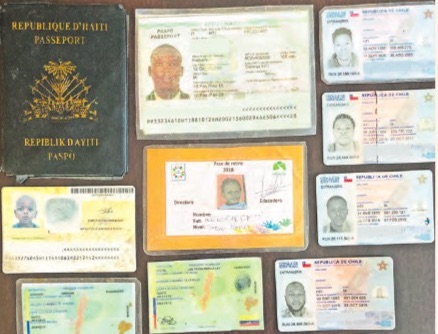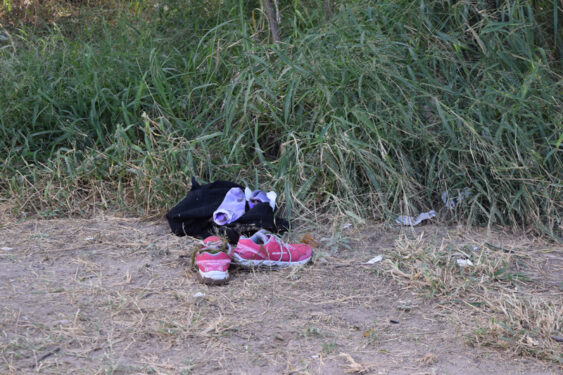DEL RIO, Texas — A look underneath the Del Rio International Bridge today doesn’t tell the story of what — and who — was there two weeks ago. The remains of hastily-constructed migrant camps have been cleared and tossed into six dumpsters. The dirt-grass terrain has been cured.
Other than the dumpsters, all that remains are two sets of fences beneath the bridge — an orange one where migrants waited in line for the buses and a black one to mark the encampment boundaries —along with a row of 20 or so portable toilets just outside of the bridge’s shade.
[Related: Diocesan Envoys Travel to Texas To Offer Aid to Haitian Migrants]
However, a short distance west, down a dirt road running from under the bridge along the Rio Grande River, the remnants of a humanitarian crisis involving thousands of refugees still exist. Both sides of the road are littered with all manner of trash, food containers, torn-up paperwork, and ID documents once belonging to migrants. Ragged discarded clothes line the road as well; in some cases, they dangle from the branches of trees as if they had been hung there to dry.

“None of this was here before,” said Val Verde County Sheriff Joe Frank Martinez.
Martinez drove The Tablet beyond the federal government’s border fence on Sept. 29 to witness the aftermath of the recent crisis in which 30,000 migrants crossed the Rio Grande into Del Rio over a two-week span. At one point, officials said, as many as 16,000 migrants had camped under the bridge.
At the height of the crisis, the federal government limited journalists’ access to the encampment area beneath the bridge and along the Rio Grande. Martinez can access the area whenever he needs to. As one border patrol agent passing by put it, “This is your county, you can do what you want.”
Martinez said the influx of migrants began after the federal government shut down migrant removal flights out of the Del Rio Sector in the early part of September. Videos at the height of the crisis show migrants crossing a dam less than half a mile away from the bridge.
Security in that area was back to normal as of last week. The Ciudad Acuña, Mexico, side is clear, as is the U.S. side. The only people around were two on-duty National Guardsmen and a local Ciudad Acuña man, fishing in the river.
Martinez identified a different opening a little farther down as the spot where migrants were initially crossing until they realized the dam was easier to traverse. This spot is tighter — only a small opening in the woods leading to the river. On Sept. 29, leftover trash and clothes could still be seen across the river on the Ciudad Acuña side. And three people — it’s unclear whether they were migrants or Ciudad Acuña residents — were sitting on the shore.
Directly across, on the U.S. side, was one of the dirtiest areas along the river. The ground surrounding the trees was coated with trash and barely visible. A closer look into the debris, though, revealed that more than just trash had been left behind: Many of the tossed items were IDs — passports, visas, and other such documents.
In a matter of just five minutes, The Tablet found the Brazilian ID of an 8-year-old Haitian boy that was issued in 2017; Chilean IDs of four Haitian men — one issued in 2016, two in 2018, and one in 2020; a Haitian passport and separate empty Haitian passport book; the IDs of three young Ecuadorian boys; and two temporary visas from Ecuador.

Martinez estimated that thousands of discarded IDs can be found all along the river.
Downriver from that initial crossing location, the dirt road forks. The options from there are to continue along the Rio Grande or turn right, back toward the border fence. Martinez said that down the road toward the border fence is the path the migrants initially took, ending up in an open field in front of the gate, without cover from the excruciating Del Rio heat.
“There were days when 300-400 people spent the night right here on this open field. It got way hot,” the sheriff said. “The heat got to 102, 103, 104 degrees.
“That’s when the border patrol directed them underneath the bridge for shade because the border patrol stations were full.”
With the conditions being what they were, Martinez called it a “miracle” that nobody died, because initially, the migrants were struggling, without sufficient food and water.
Martinez said he first sent a few extra bodies to help the border patrol with the rising numbers on Sept. 11, and as the crisis grew he sent more and more. The Texas Department of Public Safety also sent personnel to assist border patrol because, with 15,000 migrants and only 40-50 border officers, “something could have gone bad really quick.”
Looking back at the unprecedented circumstances, he said it’s a “lesson learned” that could have ended much worse if not for “relationships that have been established over years” between local and state law enforcement, and the federal border agencies.
As for the migrants, officials have said more than 10,000 were released into the U.S. It’s unclear at this point where exactly they are headed, but Martinez is certain that none has stayed in Del Rio.
Tiffany Burrow, who leads the Val Verde Humanitarian Border Coalition facility, where border patrol agents bring migrants they release, said the same, adding: “They’re going all over the country.”

